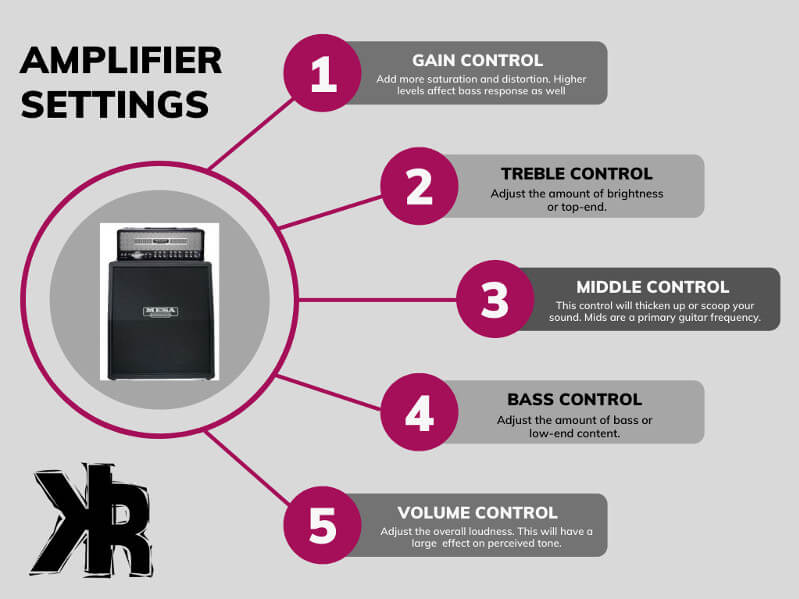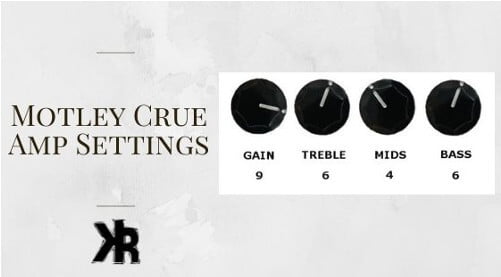Table of Contents
If you have ever seen Motley Crue live, you know that Mick Mars had a massive guitar tone! If you want to sound like him, you need to have the right amps and settings.
Getting Mick’s sound will be difficult unless you own the same amps and guitars. In this Killer Rig article, we will look at how you can get close by using Motley Crue amp settings that can be a good place to start.
What Is The Motley Crue Sound?
Motley Crue is one of the more unique sounding bands of all time. They have a very heavy guitar sound with thick distorted tones.
To get close to the Motley Crue sound, you will need to use high-gain amplifiers with a lot of distortion. The guitars need to be made to fill the part with the right amp EQ settings.
Some great settings to start with would offer a heavy guitar tone like:
- Gain: 9
- Treble: 6
- Middle: 4
- Bass: 6
- Presence: 4
Mick played multiple amps at the same time. These settings should get close to the saturated guitar tone he used. If you don’t have a high-gain amplifier, we have more settings in this guide that should help with other types.
Not sure what amp settings actually do? Check out my guide to amp controls and settings to get up to speed!
Recreating Motley Crue Amp Settings
Now that we know what the Motley Crue sound consists of, we need to know how to recreate it.
This will require the use of a high-gain amplifier like a Mesa Boogie Dual Rectifier or a Revv Generator MK3. There are many good-sounding amps, these are simply examples for reference.
There are a few things to consider before you begin dialing in your equipment.
- The guitar you use will need to have the right pickups with a good output level. A guitar with humbuckers is suggested, something made for this type of music. A stratocaster with single coils may not provide you the result you seek.
- The amplifier needs to be capable of this kind of tone. If you have a good amp, but it just can’t quite get there, you might consider a boost to push it a bit more. This can normally provide a more saturated sound.
To get the Motley Crue sound, it is essential to know how each control on your amplifier affects your tone.
Take a look at our Dimebag Darell amp settings here!

Gain Control
Using your gain knob will allow you to get more distortion and saturation in your tone. This is a very powerful control because as you increase it, you will also get more mid and bass frequencies.
Learning how to use it will help you get a better sound, so just keep in mind that it also affects your EQ organically. For Motley Crue settings, this needs to be fairly high.
Treble
The treble knob is pretty self-explanatory, but it will also affect the amount of bite in your tone. If you have it turned up too high, you will get a very fizzy overdrive sound, depending on your amp. Try and keep it bright but not harsh.
Middle
The middle control will give you more body and fullness in your tone. If you have it turned down, your tone will be scooped.
This is an essential knob to use because it can help fill out your sound and cut through the mix. Motley Crue amp settings will require midrange to be somewhere around 5-6.
Check out these great Eddie Van Halen amp settings here!
Bass
Your bass control will affect the amount of low end in your tone. If it’s turned up too high, you will get a very boomy sound with lack of clarity. But this also depends on your gain settings.
For Motley Crue settings, you will need a thicker sound, almost on the edge of muddy. So, experiment with your particular amplifier.
Presence
The presence knob will give you more attack and definition in your tone. It is essential to have this control turned up. It will help your guitar stand out over other instruments.
Amp Settings For Popular Motley Crue Songs
Use amps like Soldano, Mesa Boogie, or Revv. They have saturated distortion, and a good low-end thump can be great for Motley Crue songs. These settings will get you in the neighborhood when using these types of amps.
Kick-start My Heart
For this song, you will need to have a lot of distortion. Some good settings are as follows:
- Gain: 8
- Treble: 6
- Middle: 4
- Bass: 6-7
- Presence: 5
- Depth: 6
For the cleaner part, just roll back your volume on the guitar to get this tone. The distortion will turn to a good crunch tone that will allow you to stay on the same channel.
Dr. Feelgood
This is another song that requires a lot of distortion. A good place to start would be:
- Gain: 6-7
- Treble: 6
- Middle: 5
- Bass: 7
- Presence: 4
- Depth: 6
For any lead parts, turn up the presence a bit and get a great cut through the rest of the mix. Then lower the depth or bass.
Girls, Girls, Girls
For this song, you will need to have a thick guitar and an articulate crunch tone. Try some settings, like these:
- Gain: 6
- Treble: 5
- Middle: 5-6
- Bass: 6
- Presence: 5
- Depth: 5
Home Sweet Home
For this song, you will need to have a clean and distorted tone. But on the fly, you can also just dial back your guitar’s volume control. But we do have some good settings to try
Clean Tones
Our recommended amp settings for the clean parts in the song are:
- Gain: 3-4
- Treble: 5
- Middle: 5
- Bass: 7
- Presence: 4
- Depth: 6
Distortion Sound
To get the right distortion sound for the song, use these settings:
- Gain: 7
- Treble: 5
- Middle: 4
- Bass: 6
- Presence: 4
- Depth: 5
Additional Motley Crue Amp Setting Tips
Having trouble getting the right sounds? There are a few things to keep in mind when going for a Motley Crue sound.
- You want to keep your sound saturated. If your amplifier doesn’t do this, you may want to try a boost or distortion pedal. This can get you closer to this tone.
- A thicker sound is necessary, experiment with your mids and bass control. If your tone is already saturated, increase the bass, but don’t make it too muddy.
- Mick’s sound isn’t overly bright, so make use of your middle control to get more thickness and cut.
- Your volume setting will affect your overall tone. Lower levels will not have the same impact.
- If your sound is too thin, try turning down your treble control. This can help a great deal with a harsh tone. You might also try your guitar’s tone control, this can also be a great help.
- If your sound is too bass-heavy, try turning it down on your amplifier. You will also want to make sure you are using the bridge pickup on your guitar. This will provide a brighter rhythm tone.
- If your amplifier just can’t do this tone, try a distortion pedal. There are some great models on the market that can do this sound pretty easily. It is an affordable way to help your tone along.
Conclusion
While Mick Mars used a variety of amplifiers, any good high-gain model will get you in the ballpark for his tone. Try these settings and gear tips to help you get closer to that Motley Crue sound.
Consider using effects if you currently don’t have any for your tone. They can add depth and warmth to a struggling sound pretty easily, and are a great way to make it your own.
FAQs
What amps does Motley Crue use?
One of the things that made Motley Crue’s tone so massive sounding, was the amps that Mick used all at the same time. He used a Soldano Slo-100, Riviera Bone Head, and Marshall JCM800.
They were all set differently, some sounding thicker than others. And so he had a lot of different frequencies set to deliver a very full sound.
What guitar did Mick Mars use?
In the early days of his career, Mick used a 1972 Les Paul Custom. At least until he was forced to give it away to hang in a Hard Rock Café in Florida.
Then he began playing a heavily modified Fender Stratocaster. It was loaded with humbuckers and a Floyd rose system, which he still uses today.

